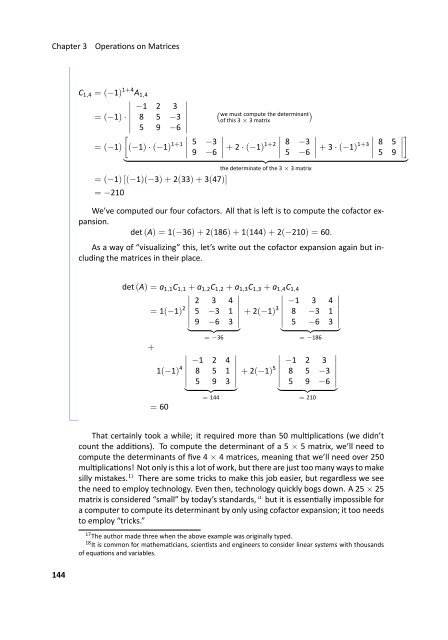Fundamentals of Matrix Algebra, 2011a
Fundamentals of Matrix Algebra, 2011a
Fundamentals of Matrix Algebra, 2011a
You also want an ePaper? Increase the reach of your titles
YUMPU automatically turns print PDFs into web optimized ePapers that Google loves.
Chapter 3<br />
Operaons on Matrices<br />
C 1,4 = (−1) 1+4 A 1,4<br />
−1 2 3<br />
(<br />
= (−1) ·<br />
8 5 −3<br />
we must compute the determinant<br />
)<br />
<strong>of</strong> this 3 × 3 matrix<br />
∣ 5 9 −6 ∣<br />
[<br />
∣ ∣ ∣ ]<br />
∣∣∣<br />
= (−1) (−1) · (−1) 1+1 5 −3<br />
∣∣∣ 9 −6 ∣ + 2 · 8 −3<br />
∣∣∣ (−1)1+2 5 −6 ∣ + 3 · 8 5<br />
(−1)1+3 5 9 ∣<br />
} {{ }<br />
the determinate <strong>of</strong> the 3 × 3 matrix<br />
= (−1) [(−1)(−3) + 2(33) + 3(47)]<br />
= −210<br />
We’ve computed our four c<strong>of</strong>actors. All that is le is to compute the c<strong>of</strong>actor expansion.<br />
det (A) = 1(−36) + 2(186) + 1(144) + 2(−210) = 60.<br />
As a way <strong>of</strong> “visualizing” this, let’s write out the c<strong>of</strong>actor expansion again but including<br />
the matrices in their place.<br />
.<br />
det (A) = a 1,1 C 1,1 + a 1,2 C 1,2 + a 1,3 C 1,3 + a 1,4 C 1,4<br />
∣ ∣ ∣∣∣∣∣ 2 3 4<br />
∣∣∣∣∣ −1 3 4<br />
= 1(−1) 2 5 −3 1<br />
+ 2(−1) 3 8 −3 1<br />
9 −6 3 ∣<br />
5 −6 3 ∣<br />
} {{ } } {{ }<br />
= −36<br />
= −186<br />
+<br />
∣ ∣∣∣∣∣ −1 2 4<br />
1(−1) 4 8 5 1<br />
5 9 3 ∣<br />
} {{ }<br />
= 144<br />
= 60<br />
∣<br />
∣ ∣∣∣∣∣ −1 2 3<br />
+ 2(−1) 5 8 5 −3<br />
5 9 −6 ∣<br />
} {{ }<br />
= 210<br />
That certainly took a while; it required more than 50 mulplicaons (we didn’t<br />
count the addions). To compute the determinant <strong>of</strong> a 5 × 5 matrix, we’ll need to<br />
compute the determinants <strong>of</strong> five 4 × 4 matrices, meaning that we’ll need over 250<br />
mulplicaons! Not only is this a lot <strong>of</strong> work, but there are just too many ways to make<br />
silly mistakes. 17 There are some tricks to make this job easier, but regardless we see<br />
the need to employ technology. Even then, technology quickly bogs down. A 25 × 25<br />
matrix is considered “small” by today’s standards, 18 but it is essenally impossible for<br />
a computer to compute its determinant by only using c<strong>of</strong>actor expansion; it too needs<br />
to employ “tricks.”<br />
17 The author made three when the above example was originally typed.<br />
18 It is common for mathemacians, sciensts and engineers to consider linear systems with thousands<br />
<strong>of</strong> equaons and variables.<br />
144

















